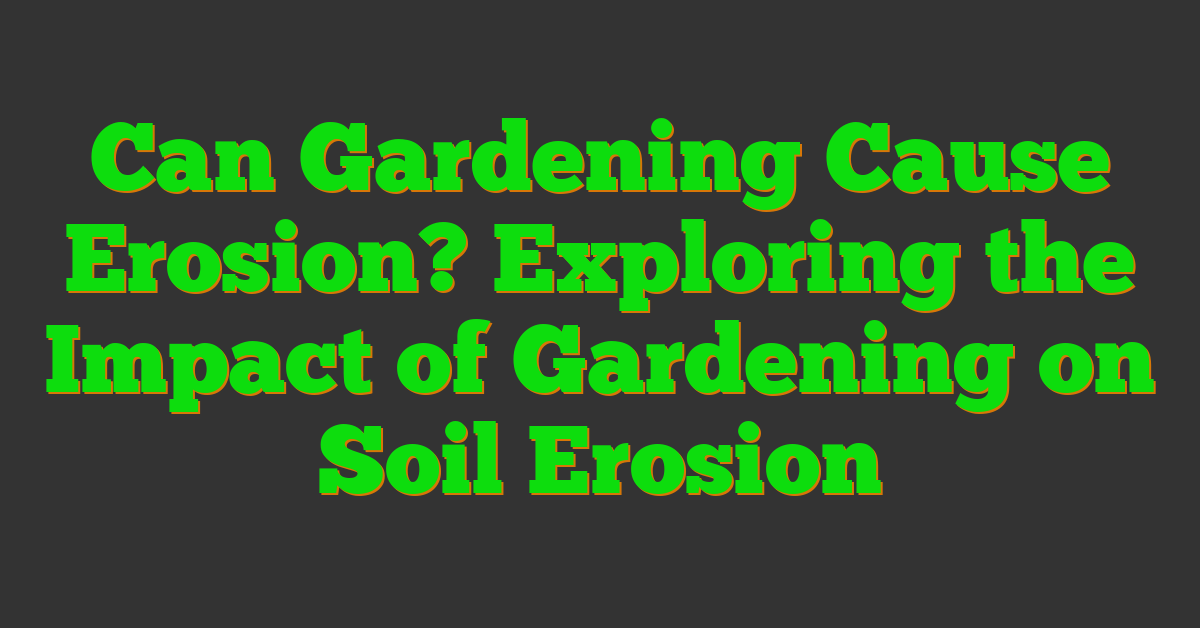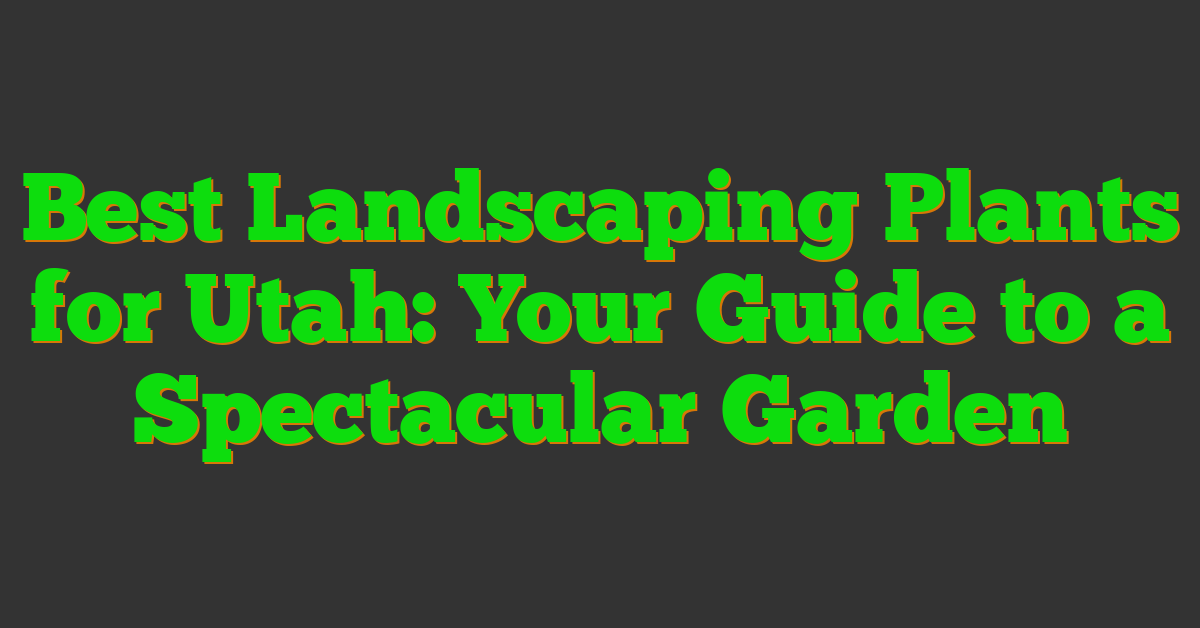If you’re an avid gardener, you may wonder if your hobby can cause soil erosion. Soil erosion occurs when soil is displaced or washed away due to natural or human-induced factors. While gardening can contribute to soil displacement, there are several ways to prevent soil erosion in your garden.

Understanding soil erosion is the first step in preventing it. Soil erosion is a natural process that can be exacerbated by human activities like farming, construction, and gardening. When soil is exposed to wind, water, or other forces, it can be carried away, leaving the ground bare and vulnerable to further erosion. Soil erosion can negatively impact soil health, reduce crop yields, and even lead to flooding.
Gardening and soil displacement often go hand in hand. Tilling, digging, and planting can all disturb the soil and increase the risk of erosion. However, there are several ways to prevent soil erosion in your garden, including using organic matter to improve soil health, planting ground cover to protect the soil, and using mulch to prevent water runoff. By taking steps to prevent soil erosion, you can enjoy a beautiful and healthy garden without harming the environment.
Key Takeaways
- Gardening can contribute to soil erosion, but there are ways to prevent it.
- Soil erosion can negatively impact soil health, reduce crop yields, and lead to flooding.
- Preventing soil erosion in your garden can be achieved through the use of organic matter, ground cover, and mulch.
Understanding Soil Erosion

https://www.youtube.com/watch?v=uo_ntewAemw&embed=true
If you’re a gardener, you may have heard about soil erosion. Soil erosion is a natural process that happens when the top layer of soil is carried away by wind, water, or other natural forces. In this section, we’ll explore the natural process of erosion, human activities that contribute to erosion, and the impact of erosion on ecosystems.
Natural Process of Erosion
Soil erosion is a natural process that has been happening for millions of years. Natural forces like wind, water, and gravity can cause soil erosion. For example, when it rains, the water can wash away the top layer of soil. This process is called sheet erosion.
Human Activities and Erosion
While soil erosion is a natural process, human activities can contribute to erosion. For example, when we clear land for agriculture or development, we remove vegetation that helps hold the soil in place. Without vegetation, the soil is more vulnerable to erosion.
Another human activity that can contribute to erosion is overgrazing. When too many animals graze on a piece of land, they can damage the vegetation and expose the soil to erosion.
Erosion’s Impact on Ecosystems
Soil erosion can have a significant impact on ecosystems. When the top layer of soil is removed, it can take years for the soil to regenerate. This can lead to a loss of nutrients and a decrease in soil fertility.
Erosion can also have an impact on water quality. When soil is carried away by water, it can end up in streams, rivers, and other bodies of water. This can lead to increased sedimentation, which can harm aquatic ecosystems.
In conclusion, soil erosion is a natural process that can be accelerated by human activities. It can have a significant impact on ecosystems, including a loss of nutrients and decreased soil fertility. As a gardener, it’s important to be aware of soil erosion and take steps to prevent it.
Gardening and Soil Displacement
https://www.youtube.com/watch?v=mUzqolWDVGk&embed=true
When you think of gardening, you might picture a peaceful and idyllic scene of plants growing and thriving. However, gardening can also contribute to soil displacement and erosion. Here are some ways that gardening can lead to soil displacement, and what you can do to prevent it.
How Gardening Can Contribute to Erosion
Gardening involves digging, tilling, and planting, all of which can disrupt the natural structure of soil. When soil is disturbed, it becomes more vulnerable to erosion from wind and water. Additionally, when you walk on soil, you can compact it, making it more difficult for water to penetrate and for plants to grow.
The Role of Water in Garden Erosion
Water is a powerful force that can cause significant soil displacement. When water runs off of your garden beds, it can carry soil with it, causing erosion. This is especially true if your garden is on a slope or if you have heavy rainfall. To prevent water erosion, you can create swales or berms to direct water flow, or use rain barrels to capture water for later use.
Wind Erosion in Gardens
Wind can also cause soil displacement in gardens, especially if you live in an area with high winds or if your garden is exposed to the elements. To prevent wind erosion, you can use windbreaks such as hedges or fences to protect your garden. Additionally, you can use mulch or cover crops to protect the soil and prevent it from blowing away.
Overall, gardening can contribute to soil displacement and erosion, but there are steps you can take to prevent it. By being mindful of how you garden and taking steps to protect your soil, you can help ensure that your garden stays healthy and productive for years to come.
Preventing Erosion in Your Garden
https://www.youtube.com/watch?v=CbdtfTs9u4s&embed=true
If you’re worried about soil erosion in your garden, there are several steps you can take to prevent it. By choosing the right plants, using soil conservation techniques, and applying mulch and ground cover, you can keep your garden healthy and prevent soil from washing away.
Choosing the Right Plants
One way to prevent erosion in your garden is to choose plants that have deep roots and can hold soil in place. Native plants are often a good choice, as they are adapted to the local climate and soil conditions. Trees and shrubs can also help prevent erosion, as their roots help hold soil in place.
Soil Conservation Techniques
Soil conservation techniques can also help prevent erosion in your garden. One technique is to terrace your garden, creating a series of level planting areas. This can help slow down water runoff and prevent soil from washing away. Another technique is to use cover crops, such as clover or rye, to protect the soil and add nutrients.
Using Mulch and Ground Cover
Mulch and ground cover can also help prevent erosion in your garden. Mulch helps to retain moisture in the soil and prevent soil from washing away. Ground cover plants, such as creeping phlox or creeping thyme, can also help hold soil in place and prevent erosion.
By taking these steps, you can prevent erosion in your garden and keep your plants healthy. Remember to choose the right plants, use soil conservation techniques, and apply mulch and ground cover to keep your garden looking great.
« Can You Take Landscape Photos with a 50mm Lens? Tips and Tricks Which is the Smallest Landscape Region in NY? »
The Role of Organic Matter in Soil Health
https://www.youtube.com/watch?v=98ZGaT7C6io&embed=true
If you are wondering whether gardening can cause erosion, it is important to understand the role of organic matter in soil health. Organic matter is a vital component of healthy soil, playing a crucial role in soil fertility and structure.
Benefits of Organic Matter
One of the primary benefits of organic matter is that it helps to retain moisture in the soil. This is because organic matter has a high capacity for holding onto water. Additionally, organic matter can help to reduce soil compaction, which can improve soil aeration and drainage. This is important because compacted soil can lead to poor root growth, which can ultimately impact plant health.
Another benefit of organic matter is that it can provide nutrients to plants as it breaks down. Organic matter is a rich source of nitrogen, phosphorus, and potassium, which are essential nutrients for plant growth. Additionally, organic matter can provide micronutrients that are not typically found in synthetic fertilizers.
Composting for Soil Fertility
Composting is a great way to add organic matter to your soil. Composting involves taking organic waste, such as food scraps and yard waste, and allowing it to decompose over time. As the organic matter breaks down, it becomes a nutrient-rich soil amendment that can be added to your garden beds.
To start composting, you will need a compost bin or pile. You can purchase a bin or make one yourself using materials such as wood pallets or wire mesh. Once you have a bin or pile, you can start adding organic waste. It is important to balance your compost with a mix of “green” materials, such as fruit and vegetable scraps, and “brown” materials, such as leaves and twigs.
In conclusion, organic matter plays a crucial role in soil health, providing a range of benefits that can help to improve plant growth and reduce erosion. Composting is a great way to add organic matter to your soil, and it is easy to get started with just a few simple steps.
Impact of Erosion on Agriculture
https://www.youtube.com/watch?v=21_NEt3238c&embed=true
If you’re an avid gardener, you may be wondering if your hobby is contributing to soil erosion. While gardening itself may not be a significant cause of erosion, it is important to understand the impact of erosion on agriculture as a whole.
Soil Quality and Crop Yields
Soil erosion can have a significant impact on the quality of soil and the yields of crops. As topsoil is eroded, it takes with it essential nutrients that crops need to thrive. This can lead to a decrease in soil fertility, which can negatively affect crop yields. In fact, according to the Union of Concerned Scientists, erosion rates are one of the reasons why prime farmland has decreased by millions of acres in recent decades.
Sustainable Farming Practices
Fortunately, there are sustainable farming practices that can help prevent erosion and maintain healthy soil quality. One such practice is the use of cover crops, which can help protect soil from erosion and improve soil health. Other practices include conservation tillage, contour farming, and crop rotation.
By implementing sustainable farming practices, you can help prevent erosion and ensure that your crops continue to thrive. Not only will this benefit your own garden, but it will also contribute to the overall health of agricultural land.
Landscaping Techniques to Combat Erosion
https://www.youtube.com/watch?v=Myj4VMssSmQ&embed=true
If you are concerned about soil erosion in your garden, there are many landscaping techniques you can use to prevent it. Here are two effective ways to combat erosion:
Retaining Walls and Structures
Retaining walls are a popular way to stop soil erosion on sloped gardens. They are structures made of concrete, stone, or wood that hold back the soil and prevent it from sliding down the slope. Retaining walls can be built in a variety of styles and sizes to suit your garden’s needs.
One way to prevent erosion is to stair-step the slope with retaining walls. This involves building a series of walls at different levels to create a terraced effect. This not only stops erosion but also creates more planting space for your garden.
Terracing Sloped Gardens
Terracing is another effective way to prevent soil erosion on sloped gardens. It involves creating a series of flat levels on a slope, which can be planted with flowers, vegetables, or other plants. Terracing not only stops erosion but also creates a more visually appealing garden.
To terrace your garden, you can use retaining walls, as mentioned earlier, or build up the soil with a series of raised beds. Raised beds are easy to build and can be made from a variety of materials, such as wood, stone, or brick. They not only prevent erosion but also improve soil drainage and aeration.
By using these landscaping techniques, you can prevent soil erosion in your garden and create a beautiful, healthy outdoor space. Remember to choose the right materials for your retaining walls and structures, and to plan your garden carefully to ensure the best results.
Frequently Asked Questions
https://www.youtube.com/watch?v=BhHqm6xRoeQ&embed=true
What are effective methods to prevent erosion around my home?
There are several effective methods to prevent erosion around your home. One of the most common methods is to plant vegetation, such as grass, shrubs, and trees, which can help to stabilize the soil and prevent it from washing away. You can also use mulch, stones, or other materials to cover bare soil and reduce erosion. Additionally, you can install retaining walls or terraces to help control water flow and prevent soil from shifting.
Where can I find landscaping services that specialize in erosion control?
You can find landscaping services that specialize in erosion control by searching online or asking for recommendations from friends, family, or neighbors. Look for companies that have experience in erosion control and are knowledgeable about the best methods for your specific landscape. You can also check with your local government or conservation district for information on erosion control services in your area.
How can I address erosion in my yard through professional services?
If you are experiencing erosion in your yard, you can address it through professional services. A landscaping professional can assess the extent of the erosion and recommend the best methods for controlling it. These may include planting vegetation, installing retaining walls or terraces, or using erosion control blankets or mats. You can also work with a soil conservationist or erosion control specialist to develop a long-term plan for preventing erosion.
What factors contribute to increased erosion on sloped landscapes?
Several factors can contribute to increased erosion on sloped landscapes. These include heavy rainfall, high winds, and the absence of vegetation or ground cover. Additionally, soil type and compaction can affect the soil’s ability to absorb water and resist erosion. Sloped landscapes are also more susceptible to erosion because water can quickly run off the surface and carry soil with it.
How do various soil types affect their susceptibility to erosion?
Various soil types can affect their susceptibility to erosion. Sandy soils are more susceptible to erosion because they have larger particles that can be easily washed away by water. Clay soils, on the other hand, are more resistant to erosion because they have smaller particles that can hold together more tightly. Loamy soils, which are a mixture of sand, silt, and clay, are generally the most resistant to erosion.
In what ways can agriculture and landscaping practices influence soil erosion?
Agriculture and landscaping practices can influence soil erosion in several ways. Tilling or plowing the soil, for example, can disrupt the soil structure and make it more susceptible to erosion. Overgrazing can also remove vegetation and expose soil, increasing the risk of erosion. Additionally, using pesticides and fertilizers can affect the health of the soil and make it more vulnerable to erosion. Proper land management practices, such as crop rotation and conservation tillage, can help to reduce erosion and maintain healthy soil.










